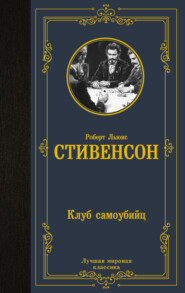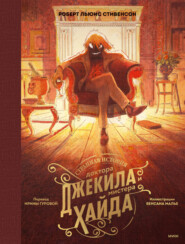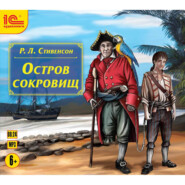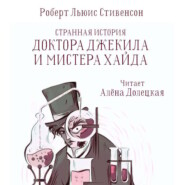По всем вопросам обращайтесь на: info@litportal.ru
(©) 2003-2024.
✖
The Works of Robert Louis Stevenson – Swanston Edition, Volume 1
Настройки чтения
Размер шрифта
Высота строк
Поля
Or will he make me an ugly tyke; and be d– to Mr. Nerli?"
When first we met, he really was "as bonny as a girlie"; with his oval face, his flushed cheeks, his brown eyes, large and radiant, and his hair of a length more romantic than conventional. He wore a wide blue cloak, with a grace which hovered between that of an Italian poet and an early pirate.
It was impossible not to discover, in a short conversation, that he was very clever, but, as a girl said once of her first meeting with another girl, "We looked at each other with horny eyes of disapproval." I thought that he was affecting the poet, and in me he found a donnish affectation of the British sportsman. He said later that I complained, concerning Monsieur Paul de St. Victor, that he was "no sportsman," though his style was effulgent.
We seldom met again, unhappily, for I was then with a family in whose company he would have been happy: all young, all kind, simple, and beautiful, and all doomed. Stevenson was then seriously ill, certainly a short walk fatigued him.
The next news I had of him was in his essay, "Ordered South," concerning the emotions, apathies, and pleasures, on that then fairy coast, of a young man who thinks that his days are numbered. After reading this paper, I was absolutely convinced that, among the writers of our generation, Stevenson was first, like Eclipse, and the rest nowhere. There was nobody to be spoken of in his company as a writer. It was not his style alone—Pater's style had bewitched me in his first book—but it was the life that underlay the style of Stevenson.
He came home, and found peace at home, and a less inadequate allowance, and he put up a brazen plate, "R.L. Stevenson, Advocate," on the door in Heriot Row. But his practice was a jest. Some senior men sought his society, his old friends were with him; his articles were welcomed by Mr. Leslie Stephen in "The Cornhill Magazine," and were eagerly expected by a few. Directed by Mr. Stephen, he found Mr. Henley in the Edinburgh Infirmary, and that friendship began which was of such considerable influence in his life and work.
Mr. Henley's "maimed strength," his impeded vigour, even his blond upstanding hair and "beard all tangled," his uncomplaining fortitude under the most cruel trials, and the candid freshness of his conversation on men and books, won Stevenson's heart.
In London, Stevenson appeared now and again at the Savile Club, then tenanting a rather gloomy little house in Savile Row. The members were mostly connected with science, literature, journalism, and the stage, and Stevenson became intimate with many of them, especially with the staff and the sub-editor (in those days) of "The Saturday Review," Mr. Walter Pollock; and with Mr. Saintsbury, Mr. Traill, Mr. Charles Brookfield, Sir Walter Besant; a little later with Mr. Edmund Gosse, who was by much his favourite in this little society. In addition to the chaff of the "Saturday" reviewers, he enjoyed the talk of Prof. Robertson Smith, Prof. W. H. Clifford, and Prof. Fleeming Jenkin.
Stevenson never wrote, to my knowledge, in "The Saturday Review"; journalism never "set his genius." For one reason among many, his manner was by far too personal in those days of unsigned contributions. He needed money, he wished to be financially independent, but, in the Press, his independence could not be all that he desired. He did not wield the ready, punctual pen of him whom Lockhart most invidiously calls "the bronzed and mother-naked gentleman of the Press."
His conversation at luncheon, and after luncheon, in the Club was the delight of all, but, for various reasons, I was seldom present. I do remember an afternoon when I had him all to myself, but that was later. He poured out stories of his American wanderings, including a tale of a murderous lonely inn, kept by Scots, whose genius tended to assassination. He knew nothing of their exploits at home, but, then or afterwards, I heard of them from a boatman on Loch Awe. Their mother was a witch!
At this period Stevenson was much in Paris, and alone, or with his cousin Bob dwelt at Barbizon and other forest haunts of painters. The chronicle of these merry days is written in the early chapters of "The Wrecker."
In literature he was "finding himself," in his Essays, but the world did not find him easily or early.
History much attracted him, as it did Thackeray, who said, "I like history, it is so gentlemanly." But it can only be written by gentlemen of independent means. Stevenson's favourite period was that of the France of the fifteenth century, and he studied later some aspects of that time in essays on Charles d'Orleans, in his admirable picture of Villon as a man and poet, and especially in "A Lodging for the Night," and "The Sieur de Malétroit's Door," shut on a windy night in the month after the Maid failed at Paris (September, 1429).
These unexcelled short stories really revealed Stevenson as the narrator, his path lay clear before him. But even his friends were then divided in opinion; some preferring his essays, and his two books of sentimental travel, "An Inland Voyage" (1878) and "Travels with a Donkey" (1879). These were, indeed, admirable in style, humour, description, and incident, but the creative imagination in the stories of Villon's night and of the Sieur de Malétroit's door, the painting of character, the romance, the vividness, were worth many such volumes. They were well received by the Press, these sketches of travel, but, as Monsieur Got says in his "Journal" (1857), "Les succès des délicats sont, même quand ils s'établissent, trop lents à s'établir. La foule s'est tellement démocratisée qu'il n'a pas de salut si l'on ne frappe brutalement." The needful brutality was not employed till Stevenson "knocked them" with "Jekyll and Hyde."
"The world is so full of a number of things," that a few essays, two or three short stories in a magazine, a little book of sketches in prose, may be masterpieces in their three several ways, but they escape the notice of all but a few amateurs. Mr. Kipling's knock was much more insistent; he could not be unheard. It was not by essays on Burns and Knox, however independently done, that Stevenson could make his mark.
Concerning these heroes, Scotland has a vision of her own, and no man must undo it; no man must tell, about Knox, facts ignored by Professors of Church History. Indeed, to study Knox afresh demands research for which Stevenson had not the opportunity. The Covenanting side of his nature appeared in his study of the moral aspect of Burns; his feet of clay. It is agreed that we must veil the feet of clay. As Lockhart says, Scott infuriated Mr. Alexander Peterkin by remarking that Burns "was not chivalrous." Stevenson went further, and annoyed the Peterkins of his day. His task required courage: it was not found wanting.
In 1877, Stevenson had a new, if very narrow, opening. A friend of his at Edinburgh University, a young Mr. Caldwell Brown (so Stevenson named him to me; his real name seems to have been Glasgow Brown), came to the great metropolis to found a Conservative weekly journal. "London" was its name, but Edinburgh was its nature, and base, if a base it had. The editor was "in the air"; he knew nothing of his business and its difficulties; nothing of what the Conservative public, with sixpences to spend, was likely to want. He approached some of Stevenson's friends, and he gave the Conservative party scores of lively ballades, villanelles, and rondeaux. They were brilliant. Stevenson would not tell me the author's name; he proved to be Mr. Henley, who came to town, and, on the death of Mr. Brown, edited this unread periodical. There were "Society" notes, although Mr. Henley's haunts were not those of that kind of society, and one occasional contributor ventured to remonstrate about the chatter on the "professional beauties" of that distant day.
The "New Arabian Nights," with all their humour, and horror, all their intellectual high spirits, and reckless absurdity, were poured by Stevenson into this outcast flutterer of a Tory paper, to the great joy of some of the very irregular contributors. (It was an honest flutterer—its contributors received their wages.)
Then "London" died, and then seriousness enough came into the life of our Arabian author. In August, 1879, he disappeared; he went to America to marry the lady whom he had first met at Fontainebleau, whom he wedded at San Francisco (1880), and loved with all his heart.
Reconciled to his father, he returned to Scotland. His health had been anew impaired by troubles and privations, and the rest of his life in the Old World was occupied by a series of maladies, vain roamings in search of climate, and hard work constantly interrupted.
From his early childhood onwards, an army of maladies surrounded him, invested him, cut him off if, in an hour of health, he ventured on any sally; but they never overcame his invincible resolution. He was, as one of his favourite old authors says about I forget what emperor, "an entertainer of fortune by the day," making the most of every sunny hour, and the best of every hour passed under the shadow of imminent death. I remember that, soon after his marriage, he was staying in London at the house of a friend. Going to see him, I noted in him a somewhat anxious look, and I did not wonder at it! Mr. Henley was seated in a great chair, the whole of his face, from the eyes downwards, muffled in a huge crimson silk pocket handkerchief, of which the point covered his aureate beard.
The room was a large room, and as Louis flitted about it, more suo, he managed to tell me privily that Henley had a very bad cold, and that he himself caught every cold which came within a limited radius. He did catch that cold, I heard, and when once such an invader entered his system, nobody knew what the end of it might be. His lungs usually suffered; hemorrhage was frequent and often alarming. In one of these accesses, unable to speak, he wrote, "Do not be frightened. If this is the end it is an easy one."
Many scraps written by him in circumstances like these used to exist; some of them, though brief, were rich in the simple eloquence of indignation.
Almost no climate did him any good: in 1880-1881, he chiefly suffered at Davos, and in the tempests of September, in Braemar. At Davos he had few consolations except the society of Mr. J. A. Symonds (the Opalstein of his essay on "Talk and Talkers") and his family. He was still attached to the indigent Muse of History: meditating a "History of the Highlands," and another book on that much trampled topic, the Union of 1707. When one thinks of the commercial statistics necessary to the student of the Union—to take that grim aspect of it alone—enfin, "I have been there, and would not go." In the nature of things the History of the Union would have become a romance, with that impudent, entertaining rogue, Ker of Kersland, and his bewildered Cameronians, for the heroes: with Hamilton the waverer, and the dark, sardonic Lockhart of Carnwath, and Daniel Defoe as the English looker-on. The study of Highland history led to the reading of the Trial of James of the Glens, and the vain hunt for Alan Breck, and so to "Kidnapped."
Stevenson felt and described the exhilaration of Alpine mornings, but his style was as sensitive as his bronchial apparatus, and he declares that when he tried to write, the style suffered from "yeasty inflation," while his nights were haunted by the nightmares of his childhood.
The next change carried him to a cottage near Pitlochry, whence he wrote that he was engaged in the composition of "crawlers." The first and best of these, "Thrawn Janet," was (with his "Tod Lapraik" in "Kidnapped") the only pendant to Scott's "Wandering Willie's Tale," in the northern vernacular. The tale has a limited circle; no Southern can appreciate all its merits, the thing is so absolutely and essentially Scots; especially the atmosphere. He said that it was "true for a hill parish in Scotland in old days, not true for mankind and the world." So it is fortunate to be a native of a hill parish in Scotland!
"The Merry Men," as "a fantasia or vision of the sea," is excellent; the poor negro never was, to myself, "convincing." However, knowing Stevenson's taste in art, I designed for him, in Skeltic taste, an illustration (coloured) of the negro pursuing the wicked uncle (in the philabeg) over the crests of Ben Mor, Mull.
Descending from these heights, Stevenson, like every bookish Scot, "ettled at" a professorial chair—that of "History and Constitutional Law," in the University of Edinburgh.
The election was in the winter, the legist and historian occupied the autumn in composing the first half of "Treasure Island" (originally "The Sea Cook").
Everyone knows the story: how, playing with his stepson, Stevenson drew a map of an island—an island like a dragon seyant; considered the caves and hills and streams, and thought of the place as a haunt of these serviceable pirates, who always dumped down their hard-earned swag on distant and on deadly shores, which they carefully abstained from revisiting. The legends of Captain Kidd's caches have long haunted the imagination; the idea of Hidden Treasure has its eternal charm, and the story thereof was told, once for all, by Poe. Soon after "Treasure Island" appeared there was a real treasure hunt. The deposit, so I was informed, was "put down by a Fin," and Mr. Rider Haggard and I were actually paying (at least Mr. Haggard sent me a cheque) for shares in this alluring enterprise, when I learned that the Fin (or Finn? a native of Finland), had looted the church plate of some Spanish cathedral in America. Knowing this, I returned his cheque to Mr. Haggard; happily, for the isle was the playroom of young earthquakes, which had upset the soil and the landmarks to such a degree that the gentleman adventurer returned—bredouille! I hope Stevenson had nothing on.
In the Highland cottage, during the rain eternal, he amused himself with writing his story, as Shelley, Byron, Polidori, and Mary Godwin had diverted themselves in Swiss wet weather, with their ghost stories, "Frankenstein," and Byron's good opening of a romance of a vampire.
Visitors came—Mr. Colvin, Mr. Gosse, and Dr. Japp—they liked the tale as chapter by chapter was read aloud, and it was offered to a penny periodical for boys. A much better market might easily have been found; indeed, Stevenson "wasted his mercies." He was paid like the humblest of unknown scribblers; not even illustrations were given to the obscure romance running in dim inner pages of the periodical, and it appears that, as Théophile Gautier's editor said about one of his narratives, "the abonné was bored with the style."
It was an audacious thing for a man of Louis's health, and intermittent inspiration, to send in half the "copy," meaning to send the rest later from Davos. He might not be able, physically, to write—the inspiration might vanish—and there was John Addington Symonds, eager for him to write on the "Characters" of Theophrastus! He might as well have written, or better, on the "Characters" of Sir Thomas Overbury, which are rather less remote from the ken of the British public than those of the Greek.
If any young man or woman, not in possession of independent means, reads these lines of mine, let him or her take warning, and deserting history, morals, the essay, biography, and shunning anthropology as they would kippered sturgeon or the devil, cleave only to fiction!
Biography also allured Stevenson—his literary tastes were nearly his ruin; he wanted, at Davos, to write a "Life of Hazlitt," and at Bournemouth a biography of Arthur, Duke of Wellington. But time and strength were lacking; nor have we R. L. S.'s mature opinion of the strategy and tactics of the victor of Assaye. The Muse of piratical enterprise returned, and "Treasure Island" reached its haven, with no applause, in the paper for boys.
In the following May, Messrs. Cassell proposed to publish "Treasure Island" in book form, being spirited up, I suppose, by Mr. Henley, who was editing for them "The Magazine of Art," in which Stevenson wrote two or three articles. (I remember that a letter of my own to "The Editor," as Mr. Henley had proudly signed himself, came automatically into the hands of the General Editor, a clergyman, if I do not err, and that my observations on the Art of Savages, lighting on the wrong sort of ground, sprang up and nearly choked Mr. Henley.) Stevenson was already the victim of the Yankee pirate, whose industry, at least, made his name, though wrongly spelled, known to the community which later paid him so well for his work, and displayed for him an enthusiasm of affectionate admiration.
In 1884 he worked at the often rewritten "Prince Otto," and did a pot-boiler—"The Black Arrow"—which pleased the boy public of the paper much better than "Treasure Island." His time, from January, 1883, to May, 1884, was passed at Hyères. In the end of November, "Treasure Island" was published in book form, and was warmly welcomed by the Press and by such friends of the author as retained, at least in letters, any smack of youth. It was forced, as far as "You must read it, please," even on the friends of the friends, and so on in successive waves, yet it did not reach a wide circle: five or six thousand copies were sold in the first year. That is failure in the eyes of many of our novelists whose style does not bore the unfastidious abonné. Stevenson, in writing an article for a magazine on his "First Book," chose "Treasure Island," for books other than novels do not count as books. He spoke of terror as the motive and interest of the tale; the dread for each and all of a mutiny headed by his ruthless favourite, John Silver. Indeed, terror, whether caused by the eccentric furies of Mr. William Bones, mariner, or of the awful blind Pew with his tapping staff, runs through the volume as the dominant motive. But there is so much else: the many landscapes, so various and so vivid; the humour of the Doctor and the Squire, the variety of the seamen's characters; the Man of the Island, with his craving for a piece of cheese; above all, John Silver. He is terrible, this coldly cruel, crafty, and masterful Odysseus of the Pacific. His creator liked him, but I could have seen Silver withering on the wuddie at Execution Dock, or suspended from a yardarm, without shedding the tears of sensibility. "A pirate is rather a beast than otherwise," says a young critic in "The Human Boy," and I cannot get over Silver gloating on the prospect of torturing Trelawny. At all events, he is an original creation, and a miraculous portent in a boy's book.
Fiercer attacks of illness in various forms drove Stevenson to Bournemouth; he was engaged, when he had the strength, on those plays (in collaboration with Mr. Henley) which prove that he had not the mysterious gift of writing for the stage. "I hope Mr. Henley wrote most of it," said a lady, as she left the theatre where she had seen "Deacon Brodie" played. Had Deacon Brodie been Archdeacon Brodie, there would have been more piquancy in the contrast of his "double life."
This idea of the double life of each man had long haunted Stevenson. He told me once that he meant to write a story "about a fellow who was two fellows," which did not, when thus stated, seem a fortunate idea. However, happily, he continued to think of Hyde and Jekyll, yet knew not how to manage them. One night, after eating bread and jam freely, he had a nightmare; he saw Hyde, pursued, take refuge in a closet, swallow "the mixture as before"—the mysterious powder or potion—and change horribly into Jekyll.
He set to work at once, and in three feverish days completed the first draft of his parable. In this the Hyde aspect was only Jekyll's unassuming disguise, adopted at hours when he wished to be a little gay. Stevenson burned his first draft, and rewrote the whole in three days.
He knew, it seems, that the magical powder was an error. One sees how the thing could be managed otherwise, with a slight strain on the resources of psychical research. But in no way could the story have attained "the probable impossible," which Aristotle preferred to "the improbable possible."
Stevenson sent the manuscript to my friend Mr. Charles Longman, who, in turn, sent it to me. I began to read it one night, in the security of a modest London drawing-room, and, naturally, it fascinated me from the first page. Then I came to a certain page, which produced such an emotion that I threw the manuscript on a chair, and scuttled apprehensively to the safety of bed. Later, a kinsman, who seldom read a book, told me that, living alone in a great Highland house, he had thrown down the printed book at the same passage, and made the same inglorious retreat. Anyone who knows the book, knows what the passage is.
The story was produced in a paper-covered volume costing a shilling, and was little heeded till a reviewer in The Times "caught this great stupid public by the ear," as Thackeray said.
The clergy of all denominations did the rest. As they had preached on "Pamela," a hundred and forty years earlier, so they called the attention of their flocks to Hyde and to Jekyll. "Who are Hyde and Jekyll, my brethren? You are Hyde and Jekyll. I am Jekyll and Hyde; each of us is Jekyll, and, alas, each of us is Hyde!"
Stevenson had long ago "found himself"; now he was found by the public. The names of his two rascally heroes (Dr. Jekyll is even less of a gentleman than Hyde) became proverbial.
The gruesome parable occupied an interval in the making of what I suppose is his masterpiece—"Kidnapped." The story centres on the Appin Murder of 1751, about which he had made inquiries in the neighbourhood of Rannoch, where Alan Breck skulked after the shooting of Campbell of Glenure in the hanging wood south of Ballachulish. Stevenson could not learn who "the other man" was—the real murderer in the romance. I know, but respect the Celtic secret. The fatal gun was found, very many years after the deed, by an old woman, in a hollow tree, and it was not the gun of James Stewart.
(I have a friend whose great-great-grandfather was standing beside James of the Glens, watching the digging of potatoes. A horse was heard approaching at such a pace that James said, "Whoever the rider is, the horse is not his own." As he galloped past, the rider shouted: "Glenure is shot!" "Who did it I don't know, but I am the man that will hang for it," said James, too truly.)
Of "Kidnapped," Stevenson said (as Thackeray said of Henry Esmond and Lady Castlewood, as Scott says of Dugald Dalgetty) that, in this book alone of his, "the characters took the bit in their teeth," at a certain point. "It was they who spoke, it was they who wrote the remainder of the story."
They are spontaneous, they are living. Balfour, in the scenario of the tale, was to have been kidnapped and carried to the American plantations. But he and Alan "went their ain gait." At the end, you can see the pen drop from the weary fingers; they left half-told the story of Alan, to be continued in "Catriona."
A love of Jacobite times, and of Alan Breck's country, Lochaber, Glencoe, Mamore, may bias me; but in "Kidnapped" Stevenson appears to me to reach the height of his genius in designing character and landscape; in humour, dialogue, and creative power. As in his preceding stories, there is hardly the flutter of a petticoat, but the tale, like Prince Charles at Holyrood, can point to a Highland man of the sword, and say, "These are my beauties." I remember that Mr. Matthew Arnold admired the story greatly, and he had no Jacobite or local bias.

















